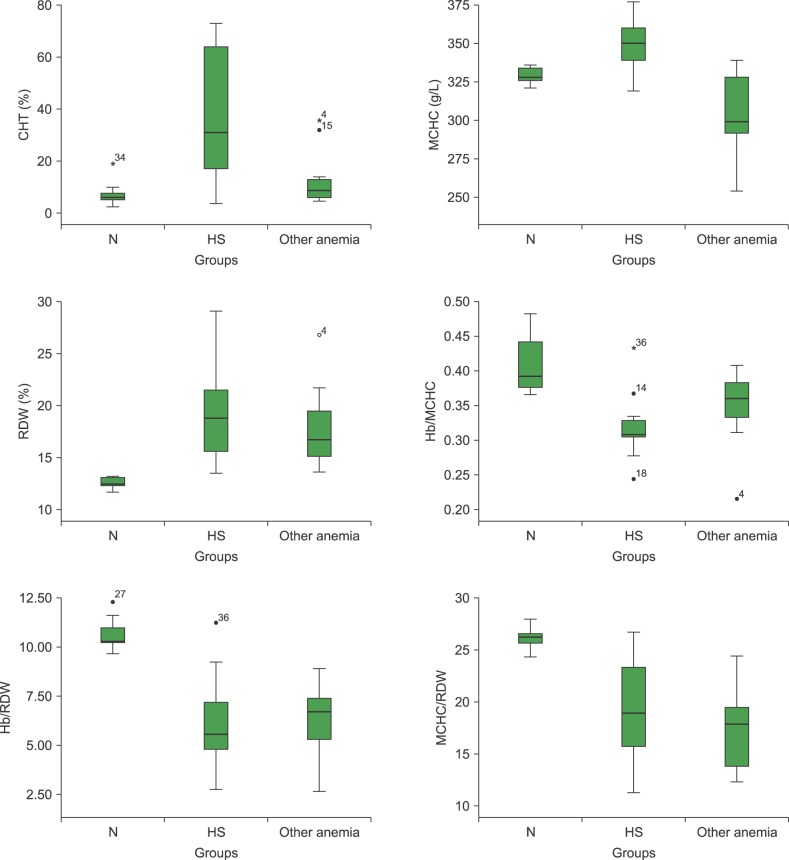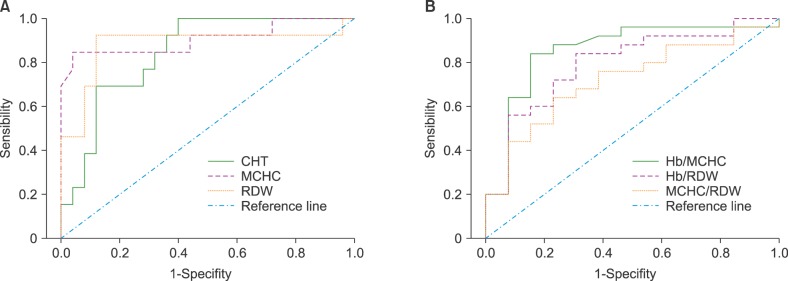Blood Res.
2018 Mar;53(1):10-17. 10.5045/br.2018.53.1.10.
Cryohemolysis, erythrocyte osmotic fragility, and supplementary hematimetric indices in the diagnosis of hereditary spherocytosis
- Affiliations
-
- 1Instituto de BioquÃmica Aplicada, Facultad de BioquÃmica, QuÃmica y Farmacia, Universidad Nacional de Tucumán, Tucumán, Argentina. slazarte@fbqf.unt.edu.ar
- 2Instituto de BiologÃa, Facultad de BioquÃmica, QuÃmica y Farmacia, Universidad Nacional de Tucumán, Tucumán, Argentina.
- KMID: 2414359
- DOI: http://doi.org/10.5045/br.2018.53.1.10
Abstract
- BACKGROUND
Hereditary spherocytosis (HS) is a chronic hemolytic anemia characterized by microspherocytes in the peripheral blood and increased erythrocyte osmotic fragility (EOF). This study evaluated the cryohemolysis test (CHT); initial hemolysis (IH); immediate and incubated hemolysis percentage in 5.5 g/L NaCl (H5.5); mean corpuscular hemoglobin concentration (MCHC); red blood cell distribution width (RDW); and Hb/MCHC, Hb/RDW, and MCHC/RDW ratios for the diagnosis of HS.
METHODS
Data from 13 patients with HS were evaluated at the Instituto de BioquÃmica Aplicada and compared with data from 14 unaffected individuals and 11 patients with anemia due to another etiology. Total blood and reticulocyte counts, CHT, and immediate and incubated EOF were performed in all subjects; sensitivity, specificity, efficiency, and Youden index (YI) were calculated.
RESULTS
Eight patients with HS had MCHC ≥345 g/L, 10 had RDW ≥14.5%, 12 had IH >5.0 g/L, 11 had immediate H5.5 ≥5%, and 13 had incubated H5.5 ≥50% (the cut-off value to consider HS). The efficiency and YI were: immediate H5.5 (0.94-0.85), incubated H5.5 (0.89-0.82), IH (0.89-0.78), MCHC (0.87-0.62), CHT (0.84-0.54), and Hb/MCHC (0.71-0.56), respectively. The calculated ratios could distinguish subjects with HS from unaffected individuals (P < 0.05), but not those with anemia of another etiology (P>0.05).
CONCLUSION
Although the CHT and supplementary hematimetric indexes were useful to differentiate individuals with SH from healthy controls, they cannot distinguish from anemias of other etiology. CHT and MCHC, in addition to EOF, are recommended for diagnosing HS patients because of their low cost and efficiency.
Keyword
MeSH Terms
Figure
Reference
-
1. Gallagher PG. Abnormalities of the erythrocyte membrane. Pediatr Clin North Am. 2013; 60:1349–1362. PMID: 24237975.
Article2. Basu A, Chakrabarti A. Defects in erythrocyte membrane skeletal architecture. Adv Exp Med Biol. 2015; 842:41–59. PMID: 25408336.
Article3. Delaunay J. The molecular basis of hereditary red cell membrane disorders. Blood Rev. 2007; 21:1–20. PMID: 16730867.
Article4. Iolascon A, Avvisati RA. Genotype/phenotype correlation in hereditary spherocytosis. Haematologica. 2008; 93:1283–1288. PMID: 18757847.
Article5. King MJ, Zanella A. Hereditary red cell membrane disorders and laboratory diagnostic testing. Int J Lab Hematol. 2013; 35:237–243. PMID: 23480868.
Article6. Bucx MJ, Breed WP, Hoffmann JJ. Comparison of acidified glycerol lysis test, Pink test and osmotic fragility test in hereditary spherocytosis: effect of incubation. Eur J Haematol. 1988; 40:227–231. PMID: 3356239.
Article7. Streichman S, Gesheidt Y, Tatarsky I. Hypertonic cryohemolysis: a diagnostic test for hereditary spherocytosis. Am J Hematol. 1990; 35:104–109. PMID: 2399901.
Article8. King MJ, Behrens J, Rogers C, Flynn C, Greenwood D, Chambers K. Rapid flow cytometric test for the diagnosis of membrane cytoskeleton-associated haemolytic anaemia. Br J Haematol. 2000; 111:924–933. PMID: 11122157.
Article9. Won DI, Suh JS. Flow cytometric detection of erythrocyte osmotic fragility. Cytometry B Clin Cytom. 2009; 76:135–141. PMID: 18727072.
Article10. Bolton-Maggs PH, Langer JC, Iolascon A, Tittensor P, King MJ. General Haematology Task Force of the British Committee for Standards in Haematology. Guidelines for the diagnosis and management of hereditary spherocytosis-2011 update. Br J Haematol. 2012; 156:37–49. PMID: 22055020.11. King MJ, Garçon L, Hoyer JD, et al. ICSH guidelines for the laboratory diagnosis of nonimmune hereditary red cell membrane disorders. Int J Lab Hematol. 2015; 37:304–325. PMID: 25790109.
Article12. Eberle SE, Sciuccati G, Bonduel M, Díaz L, Staciuk R, Torres AF. Erythrocyte indexes in hereditary spherocytosis. Medicina (B Aires). 2007; 67:698–700. PMID: 18422060.13. Rocha S, Costa E, Rocha-Pereira P, et al. Complementary markers for the clinical severity classification of hereditary spherocytosis in unsplenectomized patients. Blood Cells Mol Dis. 2011; 46:166–170. PMID: 21138793.
Article14. Streichman S, Kahana E, Tatarsky I. Hypertonic cryohemolysis of pathologic red blood cells. Am J Hematol. 1985; 20:373–381. PMID: 4073012.
Article15. Streichman S, Gescheidt Y. Cryohemolysis for the detection of hereditary spherocytosis: correlation studies with osmotic fragility and autohemolysis. Am J Hematol. 1998; 58:206–212. PMID: 9662272.
Article16. Roper D, Layton M. Investigation of the hereditary haemolytic anaemias: membrane and enzyme abnormalities. In : Lewis SM, Bain BJ, Bates I, editors. Dacie and Lewis practical haematology. 10th ed. Philadelphia, PA: Churchill Livingstone;2006. p. 205–237.17. Ledesma Achem E, Haro C, Jiménez C, Issé B, Lazarte S. Application of the cryohemolysis test in the diagnosis of hereditary spherocytosis. Biocell. 2013; abst 137. (Annual Scientific Meeting Abstracts).18. Vives-Corrons JL, Manú Pereira MM, Romeo-Casabona C, editors. ENERCA recommendations for centres of expertise in rare anaemias. A white book. Madrid, Spain: Prodrug Multimedia, S.L.;2013. p. 140–142.19. Iglauer A, Reinhardt D, Schröter W, Pekrun A. Cryohemolysis test as a diagnostic tool for hereditary spherocytosis. Ann Hematol. 1999; 78:555–557. PMID: 10647879.
Article20. Mariani M, Barcellini W, Vercellati C, et al. Clinical and hematologic features of 300 patients affected by hereditary spherocytosis grouped according to the type of the membrane protein defect. Haematologica. 2008; 93:1310–1317. PMID: 18641031.
Article21. Crisp RL, Solari L, Vota D, et al. A prospective study to assess the predictive value for hereditary spherocytosis using five laboratory tests (cryohemolysis test, eosin-5′-maleimide flow cytometry, osmotic fragility test, autohemolysis test, and SDS-PAGE) on 50 hereditary spherocytosis families in Argentina. Ann Hematol. 2011; 90:625–634. PMID: 21080168.
Article22. Park SH, Park CJ, Lee BR, et al. Comparison study of the eosin-5′-maleimide binding test, flow cytometric osmotic fragility test, and cryohemolysis test in the diagnosis of hereditary spherocytosis. Am J Clin Pathol. 2014; 142:474–484. PMID: 25239414.
Article23. Crisp RL, Maltaneri RE, Vittori DC, et al. Red blood cell aquaporin-1 expression is decreased in hereditary spherocytosis. Ann Hematol. 2016; 95:1595–1601. PMID: 27465156.
Article24. Bianchi P, Fermo E, Vercellati C, et al. Diagnostic power of laboratory tests for hereditary spherocytosis: a comparison study in 150 patients grouped according to molecular and clinical characteristics. Haematologica. 2012; 97:516–523. PMID: 22058213.
Article25. Aixála MT, Sarandría CN. Microspherocytosis. Erythroid profile and its relation with different laboratory tests. Medicina (B Aires). 2001; 61:417–423. PMID: 11563170.26. Conway AM, Vora AJ, Hinchliffe RF. The clinical relevance of an isolated increase in the number of circulating hyperchromic red blood cells. J Clin Pathol. 2002; 55:841–844. PMID: 12401822.
Article27. Michaels LA, Cohen AR, Zhao H, Raphael RI, Manno CS. Screening for hereditary spherocytosis by use of automated erythrocyte indexes. J Pediatr. 1997; 130:957–960. PMID: 9202619.
Article28. Tao YF, Deng ZF, Liao L, Qiu YL, Chen WQ, Lin FQ. Comparison and evaluation of three screening tests of hereditary spherocytosis in Chinese patients. Ann Hematol. 2015; 94:747–751. PMID: 25501660.
Article29. Bolton-Maggs PH, Stevens RF, Dodd NJ, et al. Guidelines for the diagnosis and management of hereditary spherocytosis. Br J Haematol. 2004; 126:455–474. PMID: 15287938.
Article30. Ciepiela O, Adamowicz-Salach A, Zgodzińska A, Łazowska M, Kotuła I. Flow cytometric osmotic fragility test: Increased assay sensitivity for clinical application in pediatric hematology. Cytometry B Clin Cytom. 2017; [Epub ahead of print].
Article31. Kuzminova JA, Plyasunova SA, Jogov VV, Smetanina NS. The cytometric technique of binding of eosin-5-maleimide in diagnostic of inherent spherocytosis. Klin Lab Diagn. 2016; 61:168–172. PMID: 27506108.
- Full Text Links
- Actions
-
Cited
- CITED
-
- Close
- Share
- Similar articles
-
- Flow-Assisted Differential Diagnosis of Hemolytic Anemia with Spherocytosis: A Case Report
- Splenectomy in Hereditary Spherocytosis in Childhood
- Coexistence of Gilbert Syndrome and Hereditary Spherocytosis in a Child Presenting with Extreme Jaundice
- Prolonged Extreme Thrombocytosis in a Postsplenectomy Patient with Hereditary Spherocytosis
- The Aplastic Crisis of Hereditary Spherocytosis Due to Parvovirus B19 Infection



